On Wednesday I returned from my long trip to Australia (with side trips to Papua New Guinea and Nauru). Once again I have a lot of work ahead of me now, processing my thousands of photos. Those taken with my main camera are in RAW format and hence need developing first. That alone will take a long time. So like I did before for Taiwan, I’ll give you a Post that is just a quick pre-taster with jpg.-photos taken with a compact camera and/or smartphone cameras. So please make allowances for the image quality (though in the usual small format on this Blog, the difference is not actually so starkly visible).
In this post I’ll concentrate solely on Australia (the side trips will be given separate extra Blog Posts at a later stage) and will mostly let the images speak for themselves, as a photo essay, with only essential extra information given. Let’s kick off …
The first image may come as a bit of a surprise, as it’s not about anything that is particularly Australian. This photo was taken at the Melbourne Holocaust Museum:
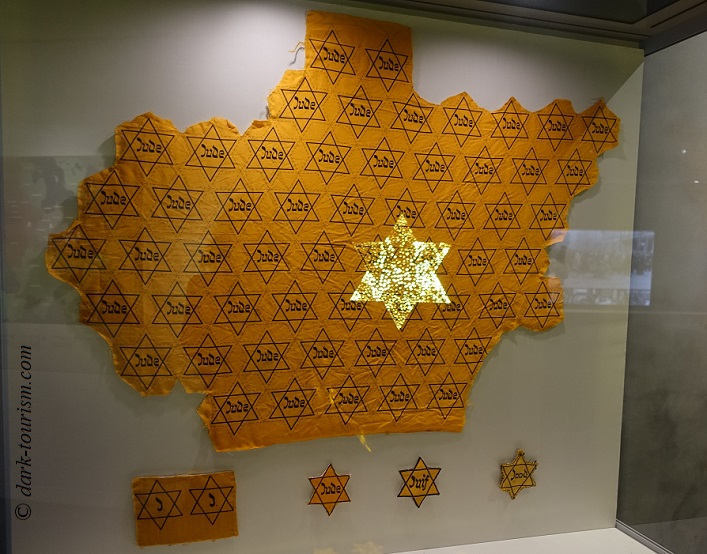
Whether these darkly iconic yellow stars, like those all Jews in the German Nazi empire had to wear, are genuine or replicas I could not ascertain. But why does Melbourne have a museum about some dark history that happened ten thousand miles away in the first place? Well, because quite a few Holocaust survivors later emigrated and settled in Australia. And it was one of those Holocaust survivors who originally initiated this museum, which has since been upgraded and modernized, of course. There are also newer Holocaust museums elsewhere in Australia – as is a global trend – and a couple of them will feature later on here too …
The next photo, also from Melbourne, was taken at one of the best-known dark-tourism sites in Australia, Old Melbourne Gaol:
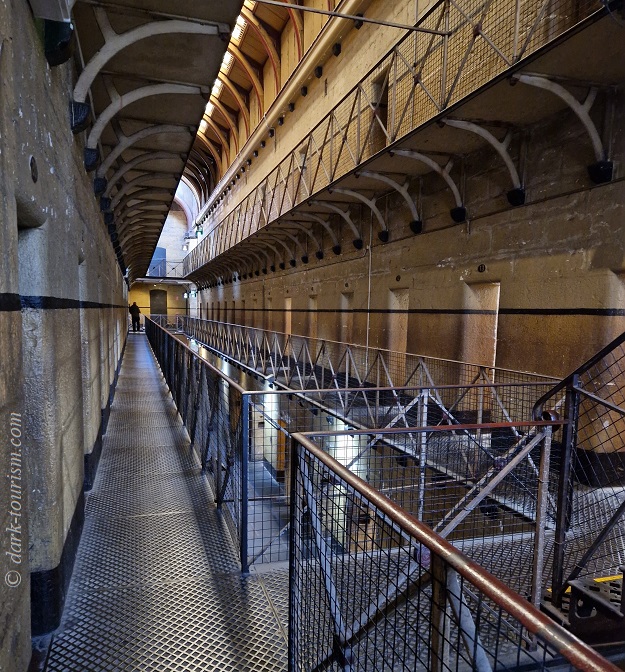
Of course, the colonial history of Australia is largely rooted in convicts sent here for the first few decades after the initial “First Fleet” landed and claimed the “new” territory for the British Empire. There are numerous convict-related sites all over south-eastern Australia and Tasmania. Many fall outside the usual time frame assumed for dark-tourism.com (which situates the concept in the modern age – see here), but some of the prisons continued to be used into more recent times, including Old Melbourne Gaol, which was closed in July 1924, so just over a century ago. It has been a museum since 1972.
I also visited another prison-turned-museum in Adelaide, and this one ceased to be a working prison much more recently, namely in 1988, and hence the present museum site looks much more contemporary. Here’s just one photo:
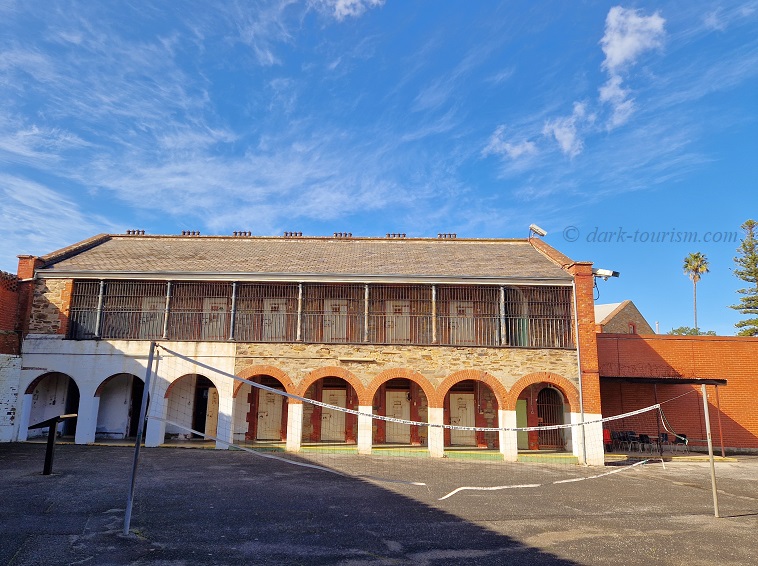
From Adelaide I hired a car for a one-week road trip into the Outback and along the south coast. My first stop was at Woomera, at the legendary missile and aerospace technology testing site. It is still operated by the RAAF (Royal Australian Air Force), including the hotel I stayed at. This too features many a space-age design, as can be seen in this next photo taken inside the hotel’s restaurant:
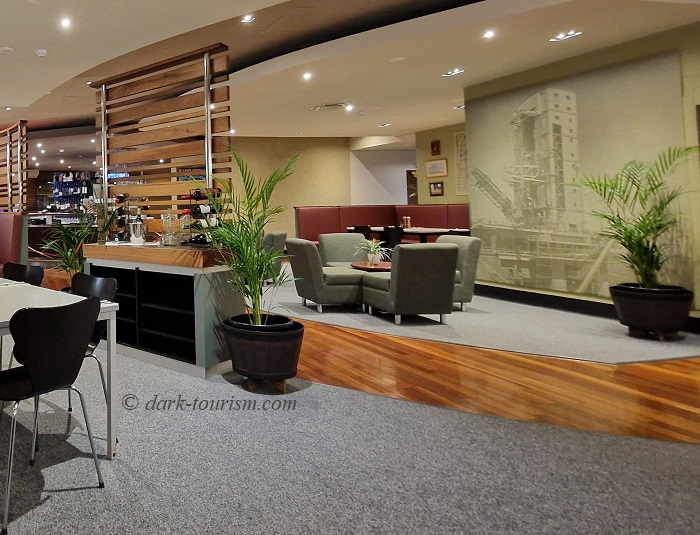
From Woomera I drove to Ceduna on the South Australian coast and from there took a fly-in trip to Maralinga. That was the nuclear test site the British set up in the 1950s in a remote part of the Outback – though not an uninhabited one. In fact the original people here, the Maralinga Tjarutja Aboriginals, were ruthlessly driven from their land and suffered a lot from the consequences of that and from the nuclear fallout. After some belated clean-up efforts, the land was officially handed back to its original owners, though almost all of them remained in settlements outside the former testing ground. Still, these days you need a permit to enter the area, but it is possible and there are guided tours you can go on. On these tours you get to see (amongst other things) several of the 1950s “ground zeros”, now highlighted by commemorative markers, such as this one where Maralinga’s final major device, code-named Taranaki, was detonated:
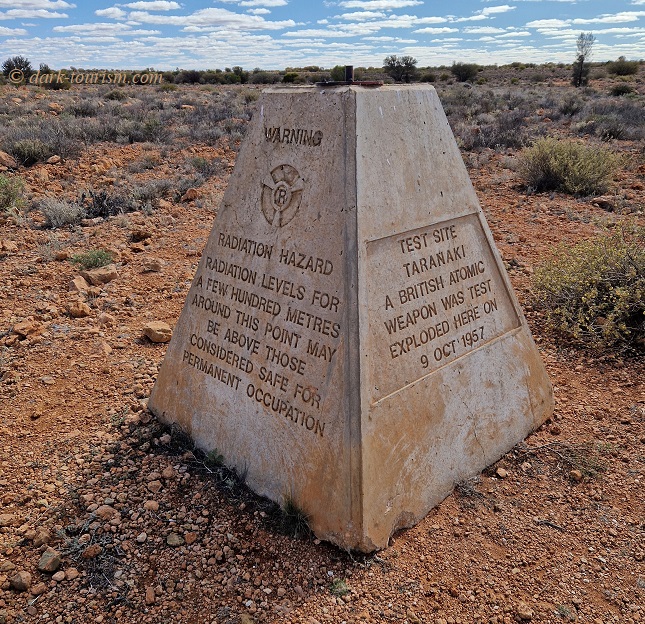
Maralinga was certainly a highlight in terms of dark tourism and may deserve a Blog Post of its own at some point.
From Ceduna I then drove on to the Nullarbor. That’s the name, meaning “no trees” in Latin, for a huge area in the western part of South Australia and into Western Australia, which is indeed completely treeless, but is largely covered by low vegetation that’s adapted to the arid conditions here. And there is also some wildlife, as the warning sign in the next photo makes clear:
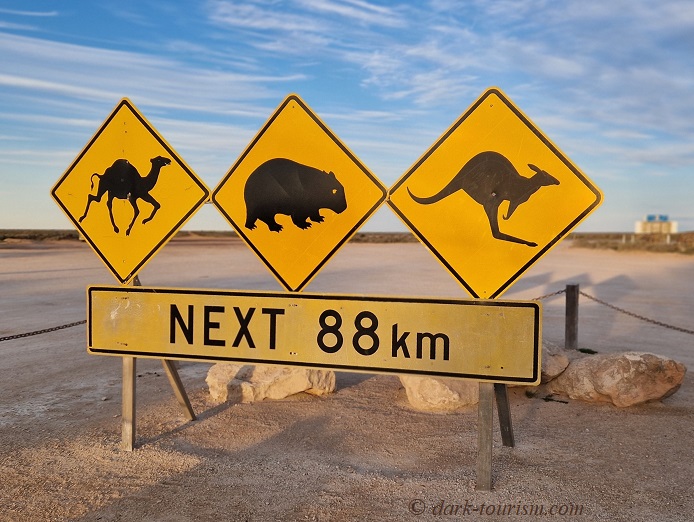
These signs are indeed for real and not just for tourist snapshots (though practically everyone who stops at the Nullarbor Roadhouse takes such a photo). And this reality comes with a dark aspect, namely for the animals concerned. Indeed I saw countless dead kangaroos and wombats by the roadside. Most of these roadkills are victims of the so-called “road trains” that thunder down the straight road through the Nullarbor Plain at all times, including at dusk when the animals are most active. Here’s a photo of one of those monsters of the road (also a nightmare to overtake, given how long they can be):
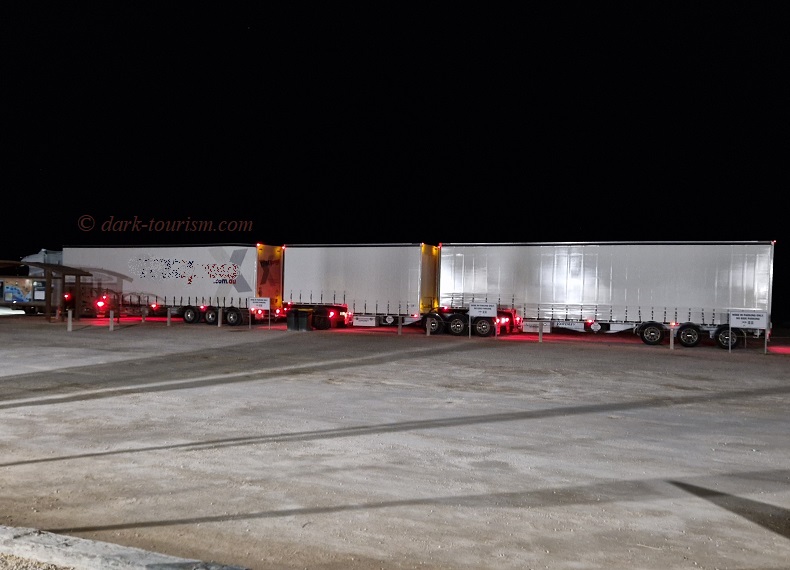
While kangaroos and wombats are native animals of Australia, camels were introduced by the colonialists and many now live wild in the Outback. And camels are about the only thing that a road train would bother braking for – simply because camels are large and tall and could cause damage and even injury to the driver if hit at full speed.
Speaking of wildlife, I also went whale watching near Nullarbor – by boat, from the clifftops, and by small plane – as it was high whale season … but as that is hardly dark tourism, I won’t add any photos from those activities here.
After I dropped the hire car off again at Adelaide airport I flew on to Hobart in Tasmania. The main reason in terms of DT for visiting Tasmania was to go on a day trip to the famous Port Arthur Historic Site. Here’s a panoramic photo of that:
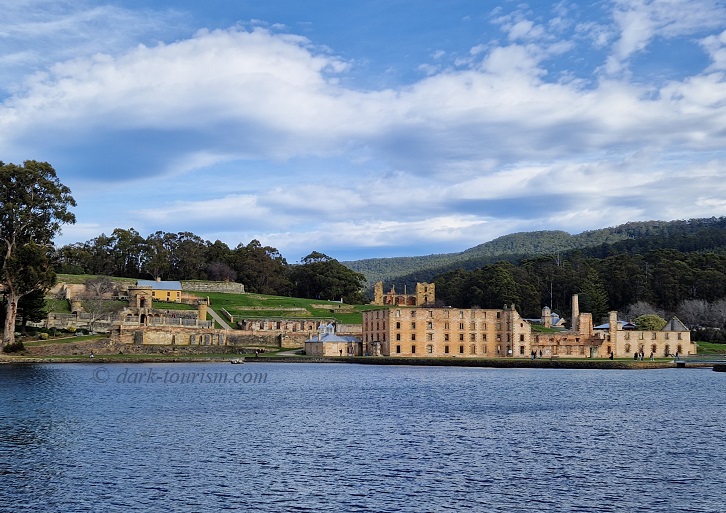
This is one of the oldest and most brutal of Australia’s convict sites, but the main reason it qualifies as a modern dark-tourism site is something altogether different. In April 1996 Port Arthur was the site of the worst mass shooting massacre in modern Australian history – 35 people lost their lives in the killing spree and many more were injured. The area where most of the random shootings took place is now a memorial site. Here’s a photo of that:
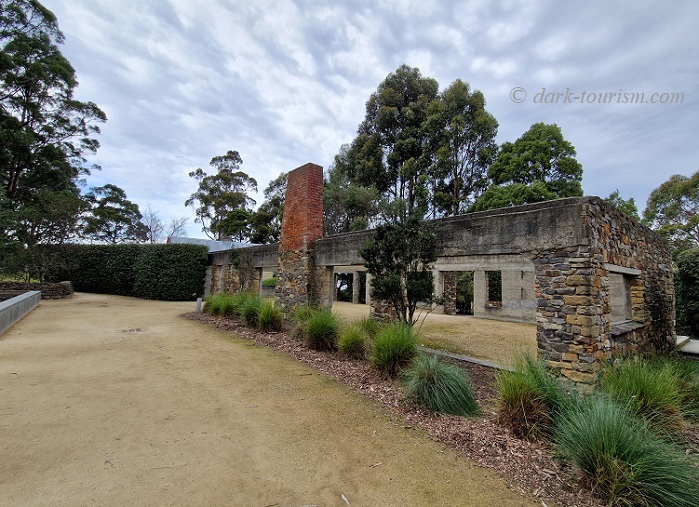
The shock that this massacre generated had a political effect: it triggered the introduction of new and very tight gun ownership legislation – of the sort that the USA refuses to consider, with the regular tragic consequences. In contrast, the legislation passed in Australia in the wake of Port Arthur has been largely successful.
From Hobart I flew to Sydney and from there on to Yulara in the so-called “Red Centre” of Australia. Yulara is home to the “Ayers Rock Resort”, the gateway for visiting Australia’s most major natural sight, formerly named Ayers Rock by the British, now referred to again as Uluru, in the local Aboriginal language. One of the tours I went on included watching the sunset turning the colour of Uluru into a deep orange glow, as seen in this next photo (same as the featured one at the top of this post):
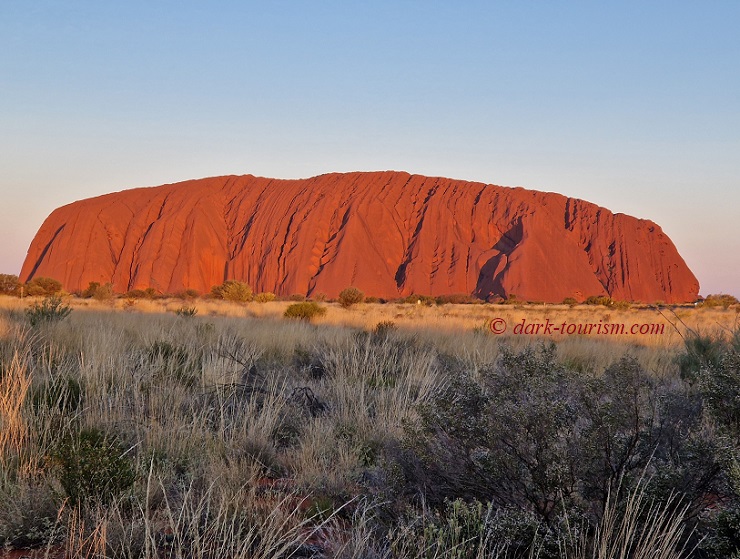
Now you might ask: why does Uluru feature here? … it’s a mainstream tourist attraction, not a dark one! That is largely correct, but not completely. Uluru was also the site of a tragedy, a multiple tragedy in fact. In August 1980, a baby girl called Azaria Chamberlain was snatched by a dingo (one of those wild dogs of Australia) at Uluru and her body was never found. Though the parents reported that their baby had been taken from their tent by a dingo, a media sensation broke out and Azaria’s mother Lindy Chamberlain was accused of murder and indeed sentenced to life imprisonment in October 1982. But then, six years after her disappearance, Azaria’s matinee jacket was discovered, namely at the place where a backpacker climbing Uluru had fallen to his death (!!) … and this was also near a (former) dingo’s den. The discovery of this piece of evidence triggered a new inquest into the Chamberlain case, leading to Lindy Chamberlain being released from prison and her conviction eventually overturned. It’s one of the most significant cases of miscarriage of justice in modern Australian history. So there are quite relevant multiple dark aspects here after all …
After Uluru I went back to Sydney and explored some of its dark sites. A prominent one is the city’s grand ANZAC Memorial, which commemorates Australians’ sacrifices in both WW1 and WWII. Here’s a photo of the main building and the water feature outside:
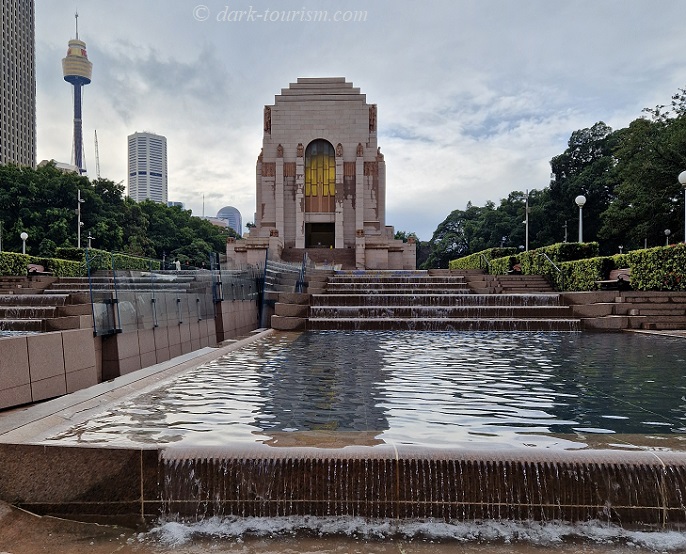
I also took a ferry out to the northern suburb of Manly, from where I got a bus up North Head to see the so-called “Q Station”. That was a place that for a long time used to serve as a quarantine station for newly arriving immigrants (so in a way it’s Australia’s equivalent of New York’s Ellis Island in the USA). The exhibition in one of the buildings also covers topics such as the post-WW1 “Spanish Flu” pandemic. Another building features the original disinfection chambers for immigrants’ luggage, as seen in this next photo:
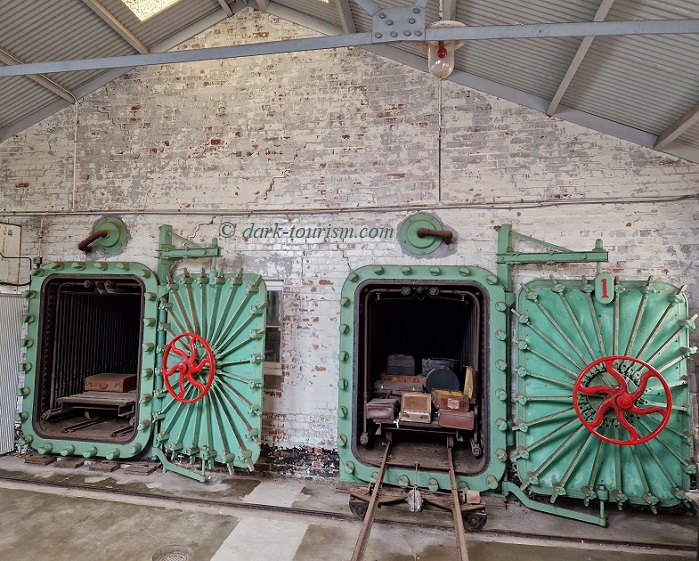
Back in the centre of Sydney I visited another main attraction, Hyde Park Barracks, seen in the next photo from the entrance gate:
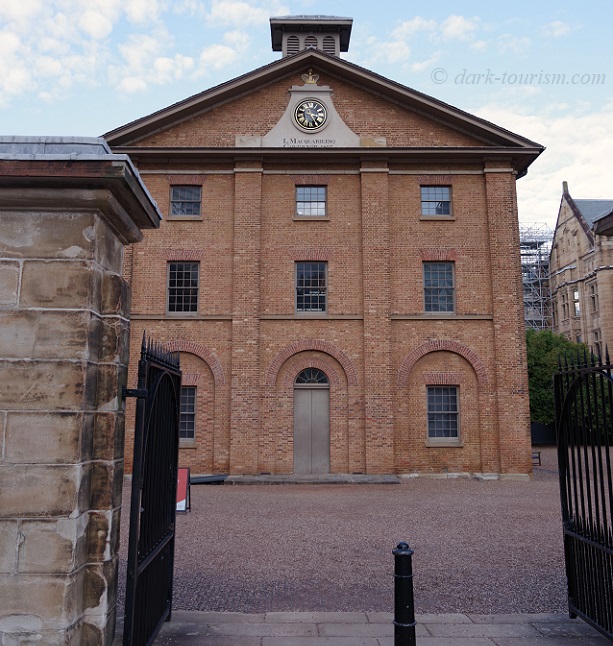
This too is linked with Australia’s early convict history but part of the exhibition inside also covers the tragic effects that the arrival of the colonialists had on the Aboriginal population, from expulsion, disease brought in by the Europeans to downright massacres. So plenty of dark here as well.
Moreover, Sydney also has its own Jewish Museum, which again largely focuses on the Holocaust. It has quite a striking interior design, as seen in this next photo:
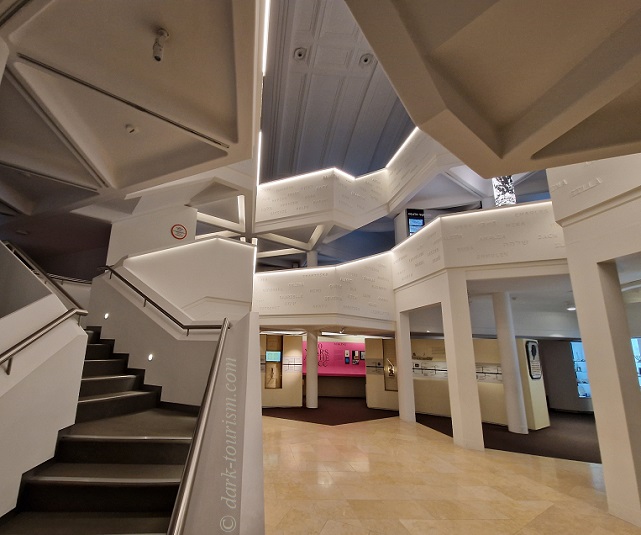
I then travelled on to Queensland’s capital city Brisbane – and there I found yet another Holocaust Museum, smaller than the other two already mentioned here, but also intriguing. Here’s a photo from the inside:
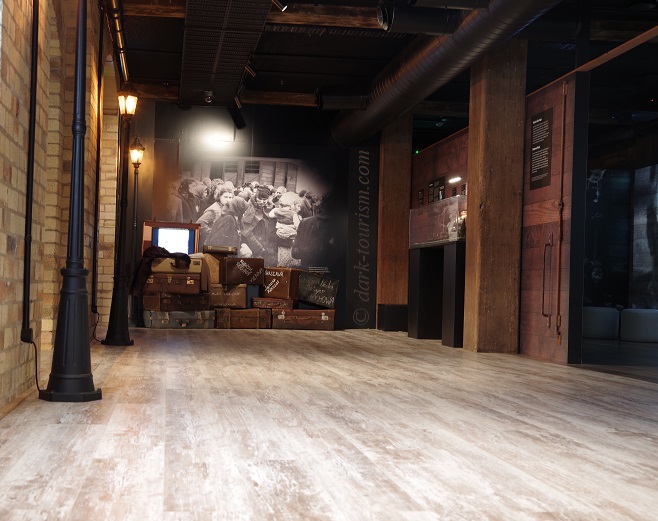
A surprise find in Brisbane was the MacArthur Museum, which I hadn’t even known about until I stumbled upon it by chance. This is primarily about General Douglas MacArthur, a key American figure in the Pacific “theatre” of WWII, who had his headquarters as supreme commander of the Southwest Pacific US Army in Brisbane from 1942. The exhibition also covers the wider context of the Pacific war and Australia’s role in it, and also includes the preserved office of MacArthur:
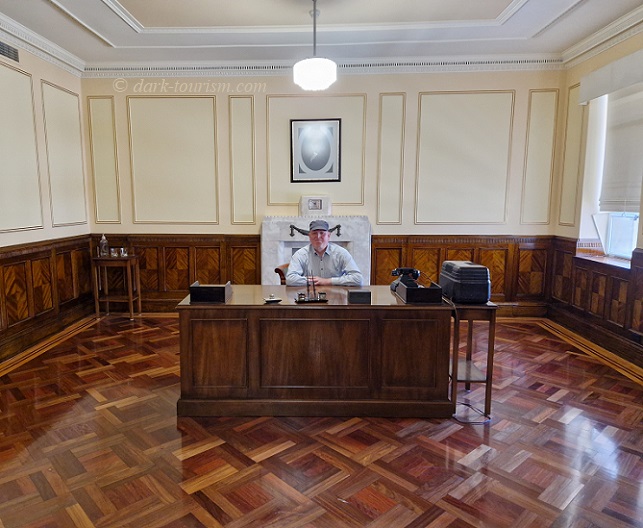
Before you ask, yes, that’s me sitting at the desk – and it was not some kind of prank or violation of museum rules; in fact museum staff explicitly urged me to take a seat there. So my wife took this posed photo …
Brisbane also has its own ANZAC Memorial, pictured from the outside in this next photo:
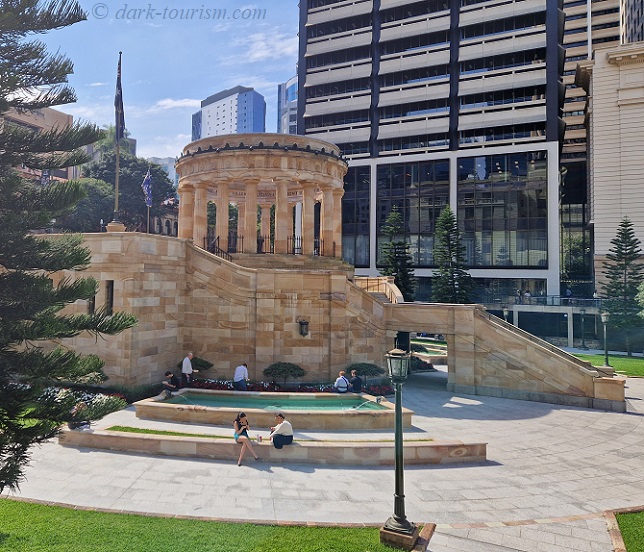
The interior featured a highly informative interactive exhibition, which I actually found better than the one inside Sydney’s equivalent.
It is however in the capital Canberra that Australia’s main ANZAC memorial is located, together with the National War Museum. Here’s a photo of the main memorial part:
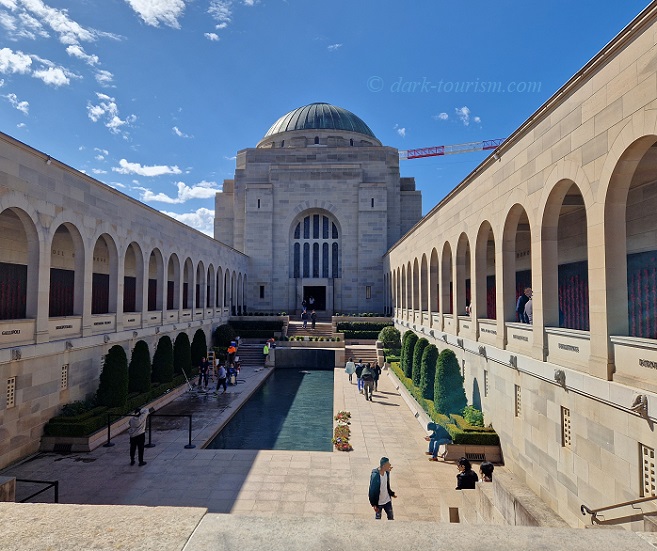
On my return to Sydney, I continued exploring its other dark sites, including Waverley Cemetery, famous for its location right by the sea on a clifftop, as seen in this next photo:
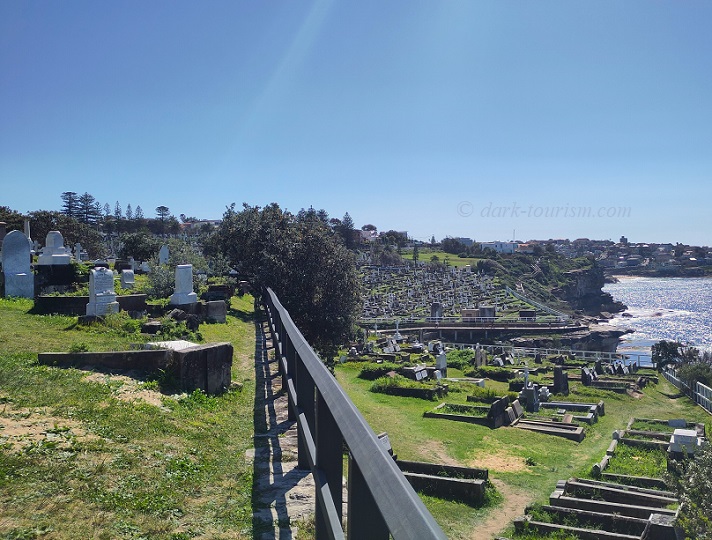
They sarcastically joke that Waverley Cemetery offers “ a view to die for”, and that’s what you indeed have to do in order to get it. In reality it’s the living who come to enjoy the views, and as the south-east coastal walk runs right past the cemetery’s clifftop front there were indeed lots of people using this and enjoying the view on the nice sunny day it was …
My final dark site in Sydney was Cockatoo Island. It didn’t actually feature any of the namesake cockatoos, but it was significantly dark in two ways. First, it too was related to Australia’s convict history. Here’s a photo from the convict quarters on the topside of the island:
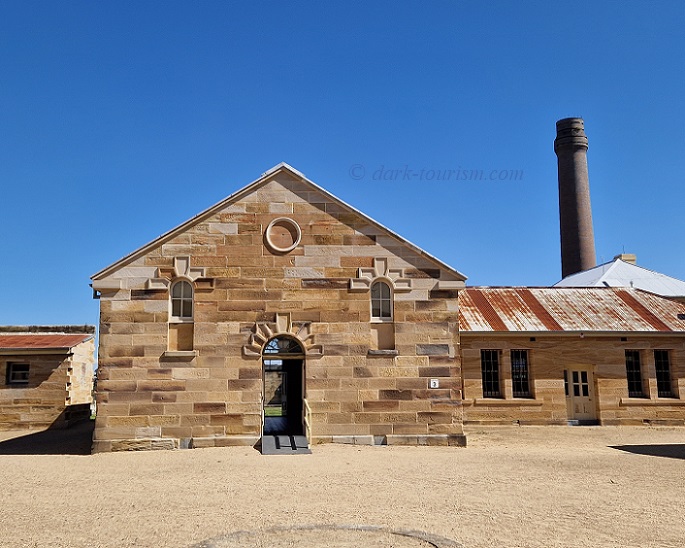
Secondly, the island was also home to naval shipyards where many an Australian warship was built and launched from. Several of the associated industrial quarters are now open to the public, including the huge turbine hall, pictured in the next photo:
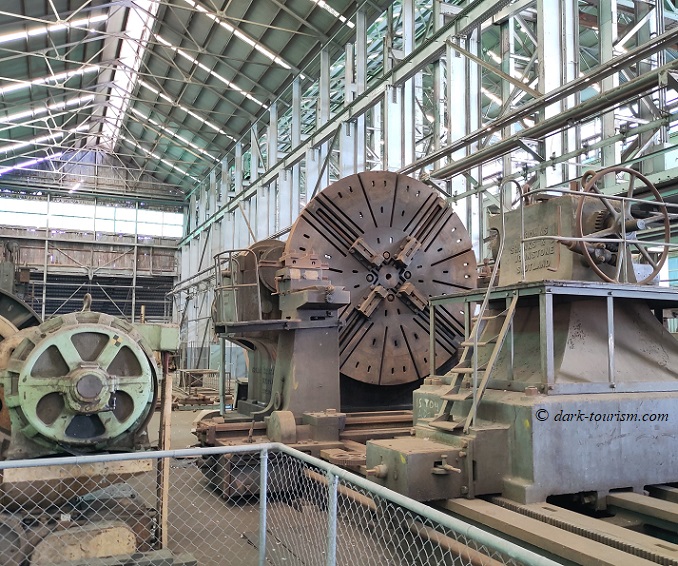
For someone like me who revels in industrial archaeology and urbexing, especially when it has its dark aspects to boot, this was one of the top highlights of Sydney!
In contrast, another ship-related aspect of tourism was rather a lowlight. When I returned to the Circular Quay in the heart of Sydney on my last day there, I saw that a gigantic cruise ship, one of those awful contemporary monsters of the seas, had docked, almost obscuring the views of Sydney’s key iconic sights:
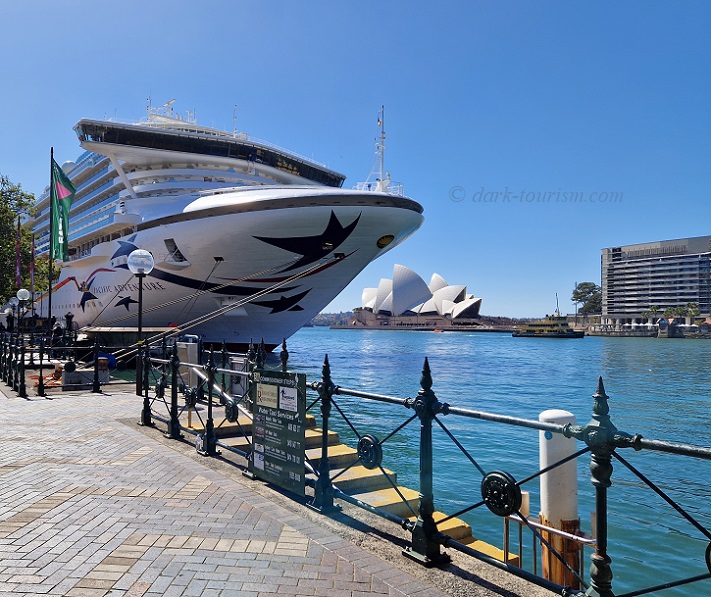
Those who know me will be aware that I find the concept of such cruising an absolute nightmare and not even ten thousand horses could ever get me aboard one of these inflated cruise ships for the masses. And it’s not just a personal preference. Cruise ships are the most environmentally unfriendly mode of travelling (yes, far ahead of flying), and for that reason alone should be boycotted. Furthermore it’s never good for the locations where they dock (apart from for the odd souvenir, passengers hardly spend anything at the destinations they visit, but eat and sleep on board the ship), and the visual impacts they can have on an iconic skyline you can see for yourself in the photo above. No wonder Venice has now banned cruise ships from the historic city … I wonder if/when Sydney may follow suit. I’d say right about now would be a very good time …
But with that slightly aside note, I’ll come to a close.
I hope you’ve enjoyed this quick photographic overview. More substantial Blog Posts about particular parts of this very long trip will follow. And of course I’ll also compose a good number of new and expanded chapters for my main website. But first of all I have to attend to all that photo processing … so please bear with me.




4 responses
Well said about cruise ships, a blight!
A very interesting report, thanks
thanks. Glad you agree …
Couldn’t agree more on cruise ships. I saw two in Istanbul recently, obscuring the view several posh hotels would normally have had of the old city and sea. Bet the people who’d paid for seafront views were pissed off.
You’ll have to go to the real Taranaki some day. Didn’t know it had had a bomb named after it.
Ah, and what a surge of memories with Lindy Chamberlain! That was a real news soap opera, covered in great detail, and at great length. A good reason not to have the death penalty – miscarriages of justice happen.
I’ve seen those sea monsters in Istanbul too – same effect.
Most British atomic bomb tests were named after places in PNG, our guide at Maralinga told us, Taranaki thus is an exception.
Lindy Chamberlain was probably lucky that the death penalty had been abolished in Australia only a few years before her case. What a story! And that it took a hiker to fall to his death for the crucial piece of evidence to be found! Aparently they have Azaria’s matinee jacket and other related items on display at the National Museum of Australia in Canberra … shame we didn’t manage to get to that museum (due to logistics and lack of time).